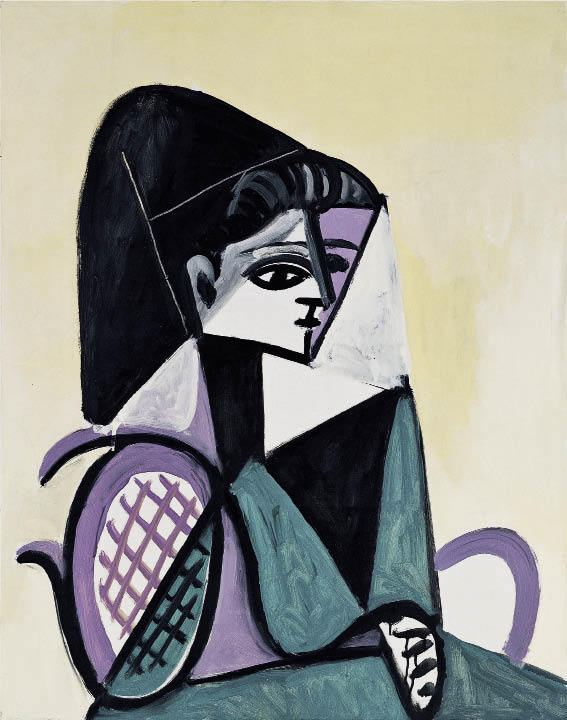Picasso: The Mediterranean Years (1945–61)
Gagosian Gallery, 6–24 Britannia Street, WC1, until 28 August
The Gagosian Gallery has been remodelled for this exhibition by the architect Annabelle Selldorf, who has translated the normally looming white spaces into a succession of more sympathetic but nonetheless dramatic rooms. The expectant visitor enters via a black door to be confronted by a large but standard earthenware vase that Picasso has transformed by painting it with a brief yellow bikini. Vase becomes woman, as Picasso reinvigorates the old cliché of womanly hips looking like a vase, and effortlessly renews the metaphor. The humour and playfulness that characterise his work are at once in evidence, and the profound preoccupation with the human figure. Picasso’s magic grips from the start.
On the opposite wall in this corridor space is the tremendous series of bull lithographs from 1945 that follows a gradual and inexorable process of stripping back from realism to the spare outlines of cave painting, from volumetric wash to pure line in 11 brilliantly inventive stages, each one a masterly reworking of the essence of bull. These should be read from left to right; at the extreme left is a swirly brown linocut entitled ‘Picador et taureau’ (1959), affectionately inscribed to John Richardson, the great Picasso biographer and the curator (with the artist’s grandson, Bernard) of this marvellous and enthralling display. Richardson’s touch is everywhere apparent, in the subtle yet informative nature of the juxtapositions, and in the choice of specific pieces as well as in the show’s overarching design. A pleasure to visit, the exhibition is also a stimulus to look again at Picasso, at his sometimes bewildering range of themes, styles and techniques.
If the visitor keeps to the right after the bull lithographs, the small end room of predominantly drawings and graphics will serve as a gradual induction to the richness of this collection. Here is a very funny series of brush drawings or croquis (sketches), called ‘Conversation’ or ‘Painter in the Studio’, also a cabinet of paper cut-outs of birds and heads. Minor works maybe, but authentic Picasso in their physical grasp and understanding of the nature of things. There are also terracotta bricks painted with faces and forms, and a couple of marvellous pencil drawings from 1954: ‘Portrait de Sylvette’ and ‘Femme couchée’, in which expressive distortion operates effectively in the service of a higher realism.
Moving back to the main room of the show, two sculptures dominate: the bronze skipping child and the wooden ‘Femme portant un enfant’. Both pieces come from Picasso’s assemblage phase, the period when he called himself ‘the king of the rag-pickers’, and spent his time scavenging on junk heaps for busted baskets and old springs, which he could expertly transform and recycle. These sculptures could be later cast in bronze to ensure their longevity (and saleability), as in the case of the famous ‘Baboon’, whose head is made from two toy cars. Round the walls are hung a number of figure paintings (lots of children) executed in whatever degree of angularity, distortion or un-finish Picasso considered appropriate. Here is an artist at the top of his form, constantly inventing new solutions. As Cocteau observed, ‘Picasso’s aesthetic consists of consecrating, of sanctifying mistakes. So he has never made a mistake.’
There are large wall cabinets of small sculptures and ceramics (a gorgeous oblong black plate particularly caught my fancy), then a dark vestibule between galleries filled with more sculptures, before the final room of mostly paintings. So much here to mention: I liked the relatively rare landscapes, especially ‘Le Village de Vauvenargues’ (1959), but my favourite picture has to be ‘Femme assise près de la fenêtre’ (1956). This highly controlled and geometrically formalised depiction of a woman at a window looking over a garden, is a deeply satisfying structure in green, grey, black and brown. Ostensibly flat, it has the illusion of great substance.
The show is accompanied by a luxurious hardback catalogue (£70), overflowing with fabulous photos of the artist and high-quality reproductions of his work. There is even a stapled insert reproducing a 1956 sketchbook of 22 pages in which we can see Picasso working through ideas with typical wit and inventiveness. Among the texts are a long contextual essay by John Richardson, a piece on the ceramics and sculpture by Elizabeth Cowling, and a fascinating portrait of Cocteau by his biographer, Claude Arnaud. I make no apologies for returning to the subject of this exhibition, mentioned only briefly in my interview with Richardson (Arts, 19 June), when he visited London for the show’s opening. This is a selection of work worthy of a museum, and I urge you to see it before it closes if you haven’t already done so. I overheard two intelligent and evidently cultured ladies remarking on the quality of the show. ‘Makes the Tate look very cheap, doesn’t it?’ opined one. Certainly the lavishness and focus of this enterprise (and the involvement of Richardson) make it the leading gallery attraction at the moment in the capital. Don’t miss it.






Comments